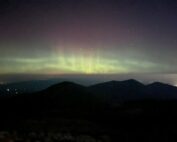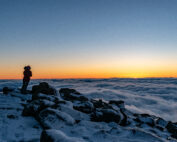Aurora on the Summit
2015-06-23 17:31:29.000 – Michael Dorfman, Weather Observer/IT Specialist
Last night’s show was absolutely incredible. While we don’t forecast aurora events here on the summit, we were waiting in anticipation for a good chance of seeing an aurora if we cleared. We were forecasted to be in the fog all evening, so we didn’t have high hopes that we would see much. Surprisingly, right around sunset, the fog cleared off the summit, giving us a beautiful view to the North. Staring into the dusky northern skies as the sun set, I was imagining what was happening, but not yet visible thanks to the bright dusk sky. At that very moment, cosmic particles were speeding towards Earth at incomprehensible speeds, deflecting off of the Earth’s magnetic field, and finally following these field lines until they dive into our atmosphere at the poles. They were colliding with the air molecules, ionizing Earth’s atmosphere and causing the well-known phenomenon called Aurora Borealis. We were crossing our fingers that we wouldn’t go back into the clouds as we waited impatiently for the dusky light to disappear on the horizon.
Finally, right around 9:45 that evening, I saw it. Faint pillars of light appeared to the naked eye on the northeastern horizon. We quickly vacated the building for the observation deck as the pillars intensified and green colors could soon be seen with the naked eye. I quickly took a shot with my DSLR and saw an impressive mix of greens and reds. While we couldn’t see too much more than green pillars, I knew this was a special event.
The human eye has two types of sensory cells in it-cones and rods. Boiled down simply, cones sense color and require a lot of light to be stimulated, and rods can function with very little light but sense only black and white. Since the night sky is very dark, we are mostly using our rod cells to look at the night sky. This is why our eyes have such a hard time seeing the faint, low-intensity red light in an aurora; there isn’t enough light to stimulate our cones, and our rods cannot see the color in the aurora. Another fun fact about the night sky: the very center of your retina and vision has a very high density of cones and a very low density of rods. If you’re ever outside trying to look at a very dim star, you often have to move your eyes to the side to stimulate your low-light rods outside of the center of your vision.
Even though our bare eyes could only see faint green and gray pillars, I could sense everyone’s excitement especially those who had never seen the aurora before. Observer Ryan Knapp brought his camera out as well, and we posed for several group shots. I was running around trying to get shots from as many angles as possible. All 8 of us wandered around the moonlit summit, taking pictures of the aurora from all different angles. At 11:00 after an hour and a half of enjoying the northern lights, I called it a night. Below are some of the images we captured last night. Enjoy!
 A very clear arc of the aurora is visible on the horizon. This arc forms due to the curvature of the earth.
A very clear arc of the aurora is visible on the horizon. This arc forms due to the curvature of the earth.
 The Observatory crew poses for a picture near the summit sign at 6288 feet.
The Observatory crew poses for a picture near the summit sign at 6288 feet.
 Observer Kaitlyn O’Brien celebrates the aurora.
Observer Kaitlyn O’Brien celebrates the aurora.
 Jupiter, Venus, the moon, the aurora and man-made light from Quebec all dance together.
Jupiter, Venus, the moon, the aurora and man-made light from Quebec all dance together.
 The aurora was spectacular even when the sky was still lit up at dusk! Here are some pillars that formed right before 10 o’clock.
The aurora was spectacular even when the sky was still lit up at dusk! Here are some pillars that formed right before 10 o’clock.And finally, a time lapse courtesy of our shift’s unofficial photographer, Ryan Knapp:
Michael Dorfman, Weather Observer/IT Specialist
From Weather Observer to Intern, to Observer Again
From Weather Observer to Intern, to Observer Again By Madelynn Smith As I rode in the backseat of our Obs van up the Auto Road for the first time as a full-time employee at
From Mountains to More Mountains
From Mountains to More Mountains: This Time with Stronger Winds By Alyssa Bélanger On the observation deck in high winds. Hello there! My name is Alyssa Bélanger and I am a fall
From Summit to Sign-Off: My Farewell to the Rockpile
From Summit to Sign-Off: My Farewell to the Rockpile By Amy Cotter Enjoying my last Mount Washington sunset (for now) on September 13, 2025. After two incredible years with the Mount Washington




